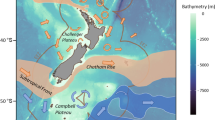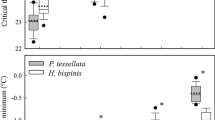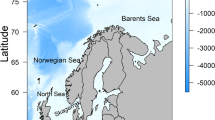Abstract
Astronotus ocellatus (oscar), is native to the Amazon basin and, although it has been introduced to many countries, little is known regarding its tolerances for salinity and temperature. In this report, we provide data on the tolerance of A. ocellatus to abrupt and gradual changes in salinity, its high and low temperature tolerance, and information on how salinity, temperature, and fish size interact to affect survival. Fish were able to survive abrupt transfer to salinities as high as 16 ppt with no mortality. When salinity change was gradual (2 ppt/day), fish in the warm-temperature experiment (28°C) survived longer than fish in the cool-temperature experiment (18°C). Larger fish survived longer than smaller ones at the higher salinities when the temperature was warm, but when the temperature was cool fish size had little effect on survival. In the temperature-tolerance experiments, fish survived from 9 to 41°C for short periods of time. Overall, the species showed a wide range of temperature and salinity tolerance. Thus, in spite of the tropical freshwater origin of this species, physiological stress is not likely to hinder its dispersal to brackish waters, especially when temperatures are warm.



Similar content being viewed by others
References
Agostinho, A. A., A. E. A. M. Vazzoler & S. M. Thomaz, 1995. The high river Paraná Basin: limnological and ichthyological aspects. In Tundisi, J. G., C. E. M. Bicudo & T. Matsumura-Tundisi (eds), Limnology in Brazil. ABC/SBL, Rio de Janeiro: 59–103.
Almeida-Val, V. M. F., A. L. Val, W. P. Duncan, F. C. A. Souza, M. N. Paula-Silva & S. Land, 2000. Scaling effects on hypoxia tolerance in the Amazon fish Astronotus ocellatus (Perciformes: Cichlidae): contribution of tissue enzyme levels. Comparative Biochemistry and Physiology B 125: 219–226.
Atwood, H. L., J. R. Tomasso, K. Webb & D. M. Gatlin, 2003. Low-temperature tolerance of Nile tilapia, Oreochromis niloticus: effects of environmental and dietary factors. Aquaculture 34: 41–251.
Barletta, M., A. J. Jaureguizar, C. Baigun, N. F. Fontoura, A. A. Agostinho, V. M. F. Almeida-Val, A. L. Val, R. A. Torres, L. F. Jimenes-Segura, T. Giarrizzo, N. N. Fabré, V. S. Batista, C. Lasso, D. C. Taphorn, M. F. Costa, P. T. Chaves, J. P. Vieira & M. F. M. Corrêa, 2010. Fish and aquatic habitat conservation in South America: a continental overview with emphasis on neotropical systems. Journal of Fish Biology 76(9): 2118–2176.
Beitinger, T. L. & W. I. Lutterschmidt, 2011. Measures of thermal tolerance. In Farrell, A. P. (ed.), Encyclopedia of Fish Physiology: From Genome to Environment. Academic Press, San Diego: 1695–1702.
Beitinger, T. L., W. A. Bennett & R. W. McCauley, 2000. Temperature tolerances of North American freshwater fishes exposed to dynamic changes in temperature. Environmental Biology of Fishes 58: 237–275.
Briggs, J. C., 2003. Fishes and birds: Gondwana life rafts reconsidered. Systematic Biology 52: 548–553.
Brown, J. A., D. M. Scott & R. W. Wilson, 2007. Do estuaries act as saline bridges to allow invasion of new freshwater systems by non-indigenous fish species? In Gherardi, F. (ed.), Biological Invaders in Inland Waters: Profiles, Distribution, and Threats. Springer, Dordrecht: 401–414.
Capps, K. A. & A. S. Flecker, 2013. Invasive aquarium fish transform ecosystem nutrient dynamics. Proceedings of the Royal Society B: Biological Sciences 280: 20131520.
Charo-Karisa, H., M. A. Rezk, H. Bovenhuis & H. Komen, 2005. Heritability of cold tolerance in Nile tilapia, Oreochromis niloticus, juveniles. Aquaculture 249: 115–123.
Cucherousset, J. & J. D. Olden, 2011. Ecological impacts of non-native freshwater fishes. Fisheries 36: 215–230.
Davis, S. E., J. E. Cable, D. L. Childers, C. Coronado-Molina, J. W. Day, C. D. Hittle, C. J. Madden, E. Reyes, D. Rudnick & F. Sklar, 2004. Importance of episodic storm events in controlling ecosystem structure and function in a Gulf Coast Estuary. Journal of Coastal Research 20: 1198–1208.
De Pinna, M. C. C., 2006. Diversity of tropical fishes. In Randall, D. J., A. L. Val & V. M. F. Almeida-Val (eds), The Physiology of Tropical Fishes. Elsevier, Amsterdam: 47–84.
Evans, D. H., P. M. Piermarini & K. P. Choe, 2005. The multifunctional fish gill: dominant site of gas exchange, osmoregulation, acid-base regulation, and excretion of nitrogenous waste. Physiological Reviews 85: 97–177.
Fontenele, O, 1951. Contribuição para o conhecimento da biologia do apaiari, Astronotus ocellatus (Spix) (Pisces, Cichlidae) em cativeiro. Aparelho de reprodução. Hábitos de desova e prolificidade. Revista Brasileira de Biologia, Rio de Janeiro 11(4): 467–484.
Fury, J. R. & F. A. Morello, 1994. The contribution of an exotic fish, the Oscar, to the sport fishery of the Everglades Water Conservation Areas. Proceedings of the Annual Conference of the Southeastern Association of Fish and Wildlife Agencies 48: 474–481.
Gertzen, E., O. Familiar & B. Leung, 2008. Quantifying invasion pathways: fish introductions from the aquarium trade. Canadian Journal of Fisheries and Aquatic Sciences 65: 1265–1273.
Gozlan, R. E., 2008. Introduction of non-native freshwater fish: is it all bad? Fish and Fisheries 9: 106–115.
Gozlan, R. E., 2009. Biodiversity crisis and the introduction of non-native fish: solutions, not scapegoats. Fish and Fisheries 10: 109–110.
Gutierre, S. M. M., J. R. S. Vitule, C. A. Freire & V. Prodocimo, 2014. Physiological tools to predict invasiveness and spread via estuarine bridges: tolerance of Brazilian native and worldwide introduced freshwater fishes to increased salinity. Marine and Freshwater Research 65: 425–436.
Hutchison, V., 1976. Factors influencing thermal tolerance of individual organisms. In Esch G. W. & R. McFarlane (eds), Symposium Series of the National Technical Information. Service: Springfield, VA: 10–26.
Julio Junior, H. F., C. D. Tós, A. A. Agostinho & C. S. Pavanelli, 2009. A massive invasion of fish species after eliminating a natural barrier in the upper Rio Paraná basin. Neotropical Ichthyology 7(4): 709–718.
Kaplan, E. L. & P. Meier, 1958. Nonparametric estimation from incomplete observations. Journal of the American Statistical Association 53: 457–481.
Keller, R. P. & D. M. Lodge, 2007. Species invasions from commerce in live aquatic organisms: problems and possible solutions. BioScience 57: 428–436.
Kleinbaum, D. & M. Klein, 1997. Survival Analysis: A Self-Learning Text. Springer, New York.
Kullander, S. O., 2003. Family Cichlidae. In Reis, R. E., S. O. Kullander & C. J. Ferraris Jr (eds), Checklist of the Freshwater Fishes of South and Central America. Edipucrs, Porto Alegre: 605–654.
Langston, J. N., P. J. Schofield, J. E. Hill & W. F. Loftus, 2010. Salinity tolerance of the African jewelfish Hemichromis letourneuxi, a non-native cichlid in south Florida (USA). Copeia 2010(3): 475–480.
Lorenzi, V. & D. Schlenk, 2014. Impacts of combined salinity and temperature extremes on different strains and species of tilapia inhabiting the watershed of the Salton Sea. North American Journal of Aquaculture 76(3): 211–221.
Lowe, M. R., W. Wu, M. S. Peterson, N. J. Brown-Peterson, W. T. Slack & P. J. Schofield, 2012. Survival, growth and reproduction of non-native Nile tilapia II: fundamental niche projections and invasion potential in the Northern Gulf of Mexico. PLoS One 7: 1–10.
Maceda-Veiga, A., O. Domínguez-Domínguez, J. Escribano-Alacid & J. Lyons, 2014. The aquarium hobby: can sinners become saints in freshwater fish conservation? Fish and Fisheries: online publication (1 Sep. 2014)
Muir, B. S., 1969. Gill dimensions as a function of fish size. Journal of the Fisheries Research Board of Canada 26: 165–170.
Muusze, B., J. Marcon, G. van den Thillart & V. M. F. Almeida-Val, 1998. Hypoxia tolerance of Amazon fish: respirometry and energy metabolism of the cichlid Astronotus ocellatus. Comparative Biochemistry and Physiology Part A 120(1): 151–156.
Myers, G. S., 1949. Salt-tolerance of fresh-water fish groups in relation to zoogeographical problems. Bijdragen tot der Dierkunde 28: 315–322.
Nelson, J. S., 2006. Fishes of the World, 4th ed. Wiley, New York.
Ng, P. K. L., L. M. Chou & T. J. Lam, 1993. The status and impact of introduced freshwater animals in Singapore. Biological Conservation 64: 19–24.
Nico, L., P. Fuller & M. Neilson, 2014. Astronotus ocellatus. USGS Nonindigenous Aquatic Species Database, Gainesville, FL. [Available at http://nas.er.usgs.gov/queries/factsheet.aspx?SpeciesID=436 accessed 15 September 2014].
Nowak, M., P. Szczerbik, K. Tatoj & W. Popek, 2008. Non-native freshwater fishes in Poland: an overview. International Journal of the Bioflux Society 1(2): 173–191.
Ospina, F. & C. Mora, 2004. Effect of body size on reef fish tolerance to extreme low and high temperatures. Environmental Biology of Fishes 70: 339–343.
Pimentel, D., 2002. Biological invasions: economic and environmental costs of alien plant, animal, and microbe species. CRC Press, Boca Raton, Florida.
Rahel, F. J. & J. D. Olden, 2008. Assessing the effects of climate change on aquatic invasive species. Conservation Biology 22: 521–533.
Rajaguru, S. & S. Ramachandran, 2001. Temperature tolerance of some estuarine fishes. Journal of Thermal Biology 26: 41–45.
Recsetar, M. S., M. P. Zeigler, D. L. Ward, S. A. Bonar & C. A. Caldwell, 2012. Relationship between fish size and upper thermal tolerance. Transactions of the American Fisheries Society 141: 1433–1438.
Sardella, B. A., V. Matey, J. Cooper, R. J. Gonzalez & C. J. Brauner, 2004. Physiological, biochemical and morphological indicators of osmoregulatory stress in ‘California’ Mozambique tilapia (Oreochromis mossambicus × O. urolepis hornorum) exposed to hypersaline water. Journal of Experimental Biology 207: 1399–1413.
Schofield, P. J., M. S. Peterson, M. R. Lowe, N. J. Brown-Peterson & W. T. Slack, 2011. Survival, growth and reproduction of non-indigenous Nile tilapia, Oreochromis niloticus (Linnaeus 1758). I. Physiological capabilities in various temperatures and salinities. Marine and Freshwater Research 62: 439–449.
Schofield, P. J., W. F. Loftus, R. M. Kobza, M. I. Cook & D. H. Slone, 2010. Tolerance of nonindigenous cichlid fishes (Cichlasoma urophthalmus, Hemichromis letourneuxi) to low temperature: laboratory and field experiments in south Florida. Biological Invasions 12: 2441–2457.
Shafland, P. L. & J. M. Pestrak, 1982. Lower lethal temperatures for fourteen non-native fishes in Florida. Environmental Biology of Fishes 7: 139–156.
Shafland, P. L., K. B. Gestring & M. S. Stanford, 2008. Florida’s exotic freshwater fishes – 2007. Florida Scientist 71: 220–245.
Sharma, S., D. A. Jackson, C. K. Minns & B. J. Shuter, 2007. Will northern fish populations be in hot water because of climate change? Global Change Biology 13: 2052–2064.
Silva, J. W. B., 2010. Biologia e cultivo do Apaiari (Astronotus ocellatus) Swainson, 1839. In Baldisserotto, B. & L. C Gomes (eds), Espécies nativas para piscicultura no Brasil. Editora UFSM, Brasil: 429–458.
Sioli, H., 1984. The Amazon and its main affluents: Hydrogeography, morphology of the river courses and river types. In Sioli, H. (ed.), The Amazon. Limnology and Landscape Ecology of a Mighty Tropical River and Its Basin. Dr. W. Junk Publishers, Dordrecht: 127–165.
Sloman, K. A., C. M. Wood, G. R. Scott, S. Wood, M. Kajimura, O. E. Johannsson, V. M. F. Almeida-Val & A. L. Val, 2006. Tribute to RG Boutilier: the effect of size on the physiological and behavioural responses of oscar, Astronotus ocellatus, to hypoxia. Journal of Experimental Biology 209: 1197–1205.
Sogard, S., 1997. Size-selective mortality in the juvenile stage of teleost fishes: a review. Bulletin of Marine Science 60: 1129–1157.
South Florida Natural Resources Center (SFNRC), 2014. DataForEVER Dataset, Everglades National Park, Homestead, FL, Generated by Gordon Anderson (USGS), using Appaserver software (http://www.appaserver.com), Sacramento, CA. Public URL not currently available, please send data requests to EVER_data_request@nps.gov. Retrieved 2 October 2014.
Stauffer Jr, J. R., 1986. Effects of salinity on preferred and lethal temperatures of the Mozambique tilapia Oreochromis mossambicus (Peters). Water Resources Bulletin 22: 205–208.
Ubeda, A. J., C. A. Simpfendorfer & M. R. Heupel, 2009. Movements of bonnetheads, Sphyrna tiburo, as a response to salinity change in a Florida estuary. Environmental Biology Fishes 84: 293–303.
Val, A. L., V. M. F. Almeida-Val & D. J. Randall, 2006. The Physiology of Tropical Fishes. Elsevier, Amsterdam.
Villegas, C. T., 1990. Evaluation of the salinity tolerance of Oreochromis mossambicus, O. niloticus and their F1 hybrids. Aquaculture 85: 281–292.
Walker, N. D., 2001. Tropical storm and hurricane wind effects on water level, salinity, and sediment transport in the river-influenced Atchafalaya-Vermillion bay system, Louisiana, USA. Estuaries 24: 498–508.
Webb, A. C. 2008. Risk Assessment Model Development for Establishment Success and Impact of Non-native Freshwater Fishes in the Wet Tropics Bioregion, Northern Queensland, Australia. Report 08/23. Australian Centre for Tropical Freshwater Research, James Cook University, Townsville.
Acknowledgments
We thank J. Schulte and D. Pecora for laboratory assistance. S. Ruessler and W. Hyde assisted with laboratory facilities. W. Loftus and S. Walsh kindly read an earlier version of the manuscript. This study was support by the US Geological Survey, Invasive Species Program and the Southeast Ecological Science Center. Also we thank CAPES (Coordenação de Aperfeiçoamento de Pessoal de Nível Superior) for financial support. All procedures were in compliance with IACUC (Institutional Animal Care and Use Committee) regulations (approved protocol USGS/SESC 2014-03). Any use of trade, product or firm names is for descriptive purposes only and does not imply endorsement by the US Government.
Author information
Authors and Affiliations
Corresponding author
Additional information
Handling editor: John Havel
Rights and permissions
About this article
Cite this article
Gutierre, S.M.M., Schofield, P.J. & Prodocimo, V. Salinity and temperature tolerance of an emergent alien species, the Amazon fish Astronotus ocellatus . Hydrobiologia 777, 21–31 (2016). https://doi.org/10.1007/s10750-016-2740-8
Received:
Revised:
Accepted:
Published:
Issue Date:
DOI: https://doi.org/10.1007/s10750-016-2740-8




